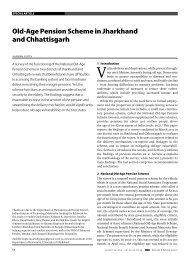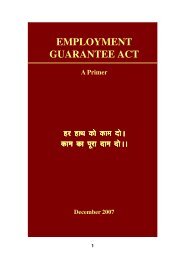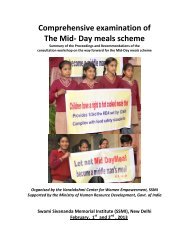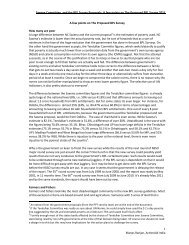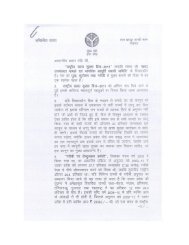NREGA: Opportunities and Challenges - Diksha
NREGA: Opportunities and Challenges - Diksha
NREGA: Opportunities and Challenges - Diksha
Create successful ePaper yourself
Turn your PDF publications into a flip-book with our unique Google optimized e-Paper software.
<strong>NREGA</strong>: OPPORTUNITIES AND CHALLENGESstaff at Panchayat level to evaluate works. Currently, according to the ministry of Panchayati raj estimate,one junior engineer is in charge of 7-10 panchayats i.e. works of around 50 villages. In between to cater tojob dem<strong>and</strong>s <strong>and</strong> exploiting the procedural glitches, district line departments have taken over thelegitimate roles of the Panchayats for faster plan approval <strong>and</strong> completion. Panchayats, thus, end upputting all their efforts in maintaining records (See box: More burdens, less capacity). And, of course,bearing the burden of local discontentment.Left aloneIt is already showing up. “<strong>NREGA</strong> is turning out to be the officials’ baby. Even at the level of Gram Sabha,it is officials who control the strings,” says Kullaya Swamy of the Centre for Rural Action, an NGO inAnantapur district that did a social audit of <strong>NREGA</strong>. For example, in Madhya Pradesh, the tehsildar has thepower to arbitrate validity of job applicants in case a complaint is lodged against the Panchayat head. Inmany states, district collectors have been made the district programme coordinators, thus diluting theprinciple of making the Panchayat institutions the ‘principal authority’ under the Act. Our evaluation of the<strong>NREGA</strong> in Karnataka <strong>and</strong> Andhra Pradesh points out that the Panchayats are not being encouraged to bein charge of the scheme. Central guidelines m<strong>and</strong>ate that an <strong>NREGA</strong> assistant should be recruited for eachof the 87,000 Panchayats where the scheme is applicable. But most states have not made suchappointments. In a survey of 13 states by the Central government, only four states have done so .Take the instance of Shivpur village in MP’s Tikamgarh district. Moneylenders <strong>and</strong> traders are after the 35-year-old Sarpanch Ramesh Singh Yadav from the village. He owes them Rs 10 lakhs. Ramesh has beenchasing the block development officials for months. He is not an indebted farmer who has taken heavyloans from these people. He just tried to implement <strong>NREGA</strong> honestly. His village was suffering the thirdconsecutive drought. The village’s mostly marginal farmers were desperate for works <strong>and</strong> a way out ofdrought. <strong>NREGA</strong> came as a boon with its focus on water conservation <strong>and</strong> assured at least 100 days in ayear of daily wage works.He started works worth with Rs 20 lakh after Gram Sabha passed resolution <strong>and</strong> the Block Developmentoffice sanctioned works relating to construction of a check dam, plantation of 300 fruit trees on roadsides<strong>and</strong> built a kilometer long road in the Shivpur village. Rs 10 lakh was provided in advance prior to start ofMORE BURDENS, LESS CAPACITY<strong>NREGA</strong> is turning out to be a major work burden for the already overworked Panchayats. The work burdenis tasking particularly because most of the states have not devolved the necessary function, funds <strong>and</strong>functionaries to Panchayats for effective implementation of the <strong>NREGA</strong>. Out of the 214 centrally sponsoredschemes targeted at rural communities, Panchayats implement 151 <strong>and</strong> have a partial role in 23 others.These total to 174 schemes, which received an allocation of Rs.33, 044 crore in 2005. Panchayats alsoimplement most of the schemes classified as ‘additional central assistance’, which are disbursed throughspecific regional anti-poverty programmes. According to the computation of the Union ministry ofPanchayati Raj, these comprise 16 schemes operated by 11 ministries <strong>and</strong> departments, worth Rs. 16,880crore in 2005. Additionally the government’s Bharat Nirman programme, which started in 2005, has acomponent to be implemented through Panchayats. Add to this the BRGF in implementation in the 200districts <strong>NREGA</strong> covered in the first phase. BRGF is implemented by Panchayats alone.Panchayats have huge administrative workload. They have to maintain accounts for as many as 76schemes on an average, which gives little room for effective on-ground implementation. In a sample studyin Madhya Pradesh <strong>and</strong> Karnataka, the World Bank found that on an average, a Sarpanch needs to keeptrack of 470 accounts <strong>and</strong> deal with 17 line departments involving 50 officials. Each activity has to be dealtseparately. There is no convergence of schemes at the village level. In the coming years Panchayats will getmore work, more money <strong>and</strong> more responsibilities. The Union ministry of Panchayati Raj has initiated aprocess through which all ministries implementing schemes in villages will have to look at their functionsrelevant to Panchayats. “Centrality of Panchayat in all government schemes is what we are looking forwardto,” says Mani Shanker Aiyer, Union minister of Panchayati Raj.49



